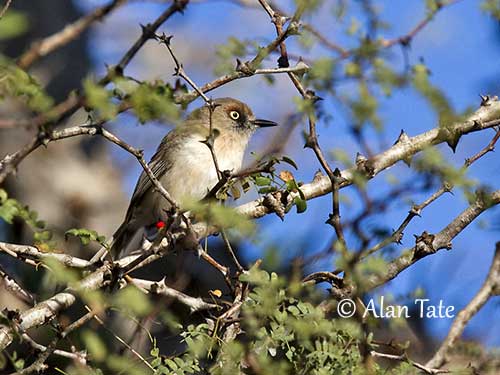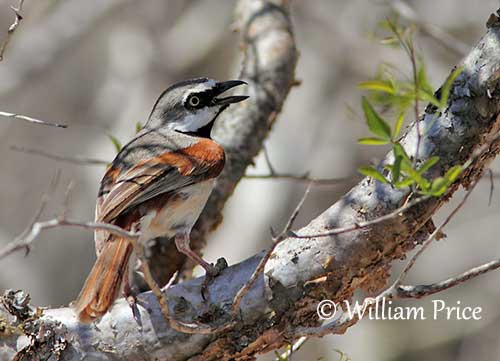
Text by Nicole Bouglouan
Photographers:
John Anderson
John Anderson Photo Galleries
Jean Michel Fenerole
Photos d’Oiseaux du monde
William Price
PBase-tereksandpiper & Flickr William Price
Dubi Shapiro
Dubi Shapiro Photo Galleries & Dubi Shapiro's Pictures on IBC
Alan & Ann Tate
AA Bird Photography
Sources:
HANDBOOK OF THE BIRDS OF THE WORLD Vol 14 by Josep del Hoyo-Andrew Elliot-David Christie - Lynx Edicions – ISBN: 9788496553507
Birds of Madagascar: A Photographic Guide Par Pete Morris, Frank Hawkins – ISBN: 0300077556, 9780300077551- Editeur: Yale University Press, 1998
The Birds of Africa: Volume VIII: The Malagasy Region: Madagascar, Seychelles, Comoros, Mascarenes - Par Roger Safford, Frank Hawkins – ISBN: 1408190494, 9781408190494- Editeur: A&C Black, 2013
Madagascar Wildlife: A Visitor's Guide Par Nick Garbutt, Hilary Bradt, Derek Schuurman – ISBN: 1841622451, 9781841622453 - Editeur: Bradt Travel Guides, 2008
Diversification and the adaptive radiation of the vangas of Madagascar
Ecological and evolutionary determinants for the adaptive radiation of the Madagascan vangas
Science Daily - Evolution: Vangas beat Darwin’s finches in diversity
Creagus – Bird Families of the World – Vangas - Vanginae
THE VANGAS OF MADAGASCAR by Nick Garbutt
Vanga - From Wikipedia, the free encyclopedia
FAMILY VANGIDAE
Vangas, Newtonias and Ward’s Flycatcher
The family Vangidae, order Passeriformes, consists of 21 species endemic to Madagascar. They represent a radiation confined within the Madagascar region.
Most of them were historically placed in the family Laniidae with the shrikes. In 1932, the vangas were recognized as a separate family by J. Delacour, using the name “Vangidés” for the first time, becoming later Vangidae. But the members of this new family were very different from the current classification.
However, in 1960, J. Dorst presented a new classification of the vangas with 14 species currently recognized as a family. The 15th species, the Red-shouldered Vanga, came later, as it was described only in 1997 by Phoebe Snetsinger. Dorst’s classification was based on morphological similarities among the members of this family.

Recently, in addition to the current taxa of the family Vangidae, some authors, on basis on DNA analysis, included in this group several additional taxa previously assigned to other families. The newtonias generally placed in the Old World Warblers, the Ward’s Flycatcher often included in the family Platysteiridae, and the Madagascar Groundhunter (now Crossley’s Vanga placed in the family Timaliidae should be placed in Vangidae. This arrangement has been the preferred by most recent authors.
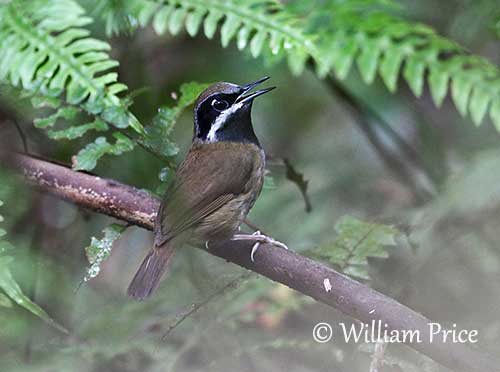
From a detailed study undertaken by S. Yamagishi and colleagues, the Vangidae have a closer relationship with the butcherbirds (Cracticidae family) than they do with the shrikes (Laniidae). It appears that the common ancestor of the vangids simultaneously differentiated into five lineages within a relatively short period after arriving on the island. Five groups are recognized, and there are similarities between some of them.
The bill shapes vary greatly within each group as demonstrated by the Sickle-billed Vanga and the White-headed Vanga, and the Helmet Vanga and the Rufous Vanga, but there are close similarities in plumage coloration.
The development of such variation in bill size and shape has occurred more rapidly than the variation in plumage coloration which has been more gradual.
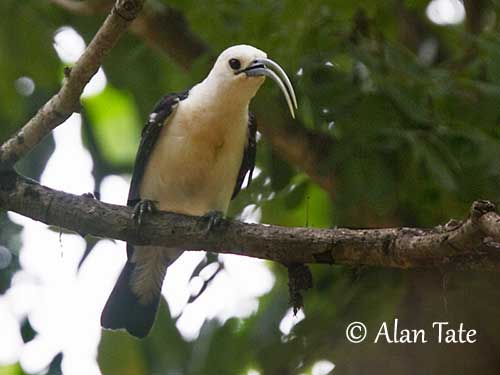
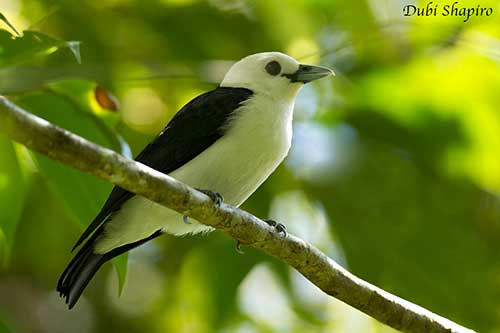
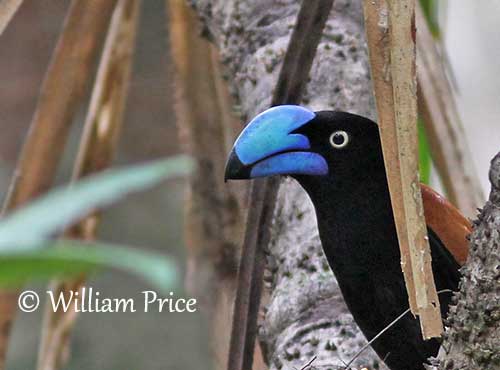
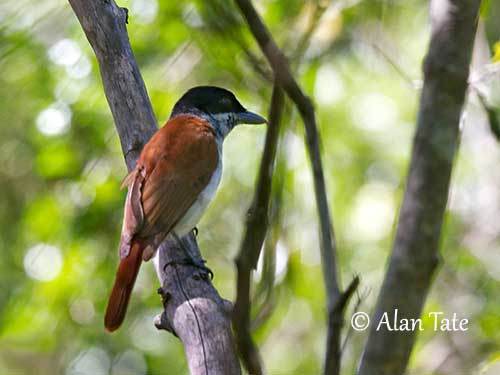
The genus Newtonia is endemic to Madagascar, and following some genetic analyses, it is suggested that Newtonia is a product of the same Malagasy radiation from which the Vangidae (vangas) originated. Voice and nest structure also suggest this origin. We can find four species, the Common Newtonia, the Archbold’s Newtonia, the Red-tailed Newtonia, and the Dark Newtonia.
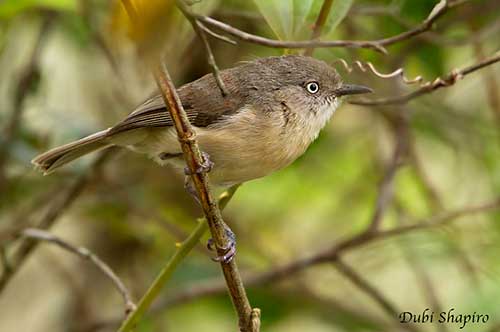
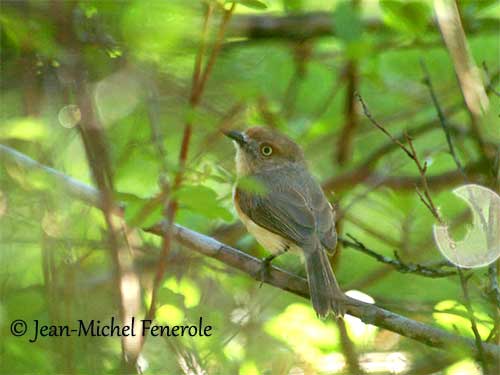
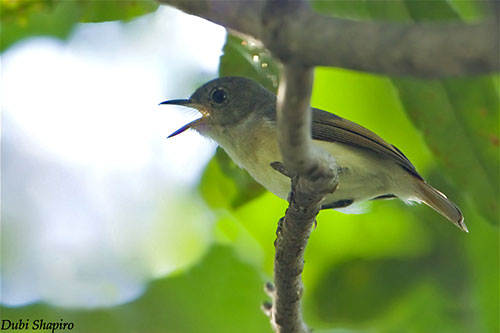
The Ward’s Flycatcher is the sole member of genus Pseudobias. It was formerly included in the family Platysteiridae that occurs in continental sub-Saharan Africa and some offshore islands. The Ward’s Flycatcher was named Ward’s Shrike-flycatcher. It was the only one that has colonized the island of Madagascar. But several morphological features, vocalizations and behaviour make it different from the other members of the family. It appears finally that this species may be an off-shoot of the endemic passerine lineage of Madagascar, the Vangidae.
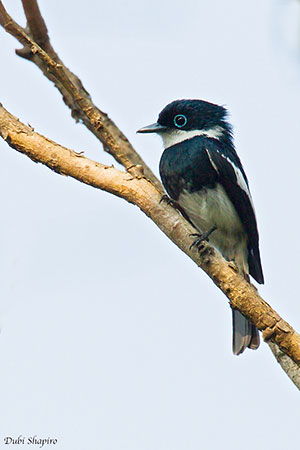
The Crossley’s Vanga was formerly named “Madagascar Groundhunter” and this name describes very well the foraging behaviour of this terrestrial species that gleans invertebrates from the ground. It is the sole member of the genus Mystacornis. The inclusion of this species within the Vangidae adds another foraging niche.
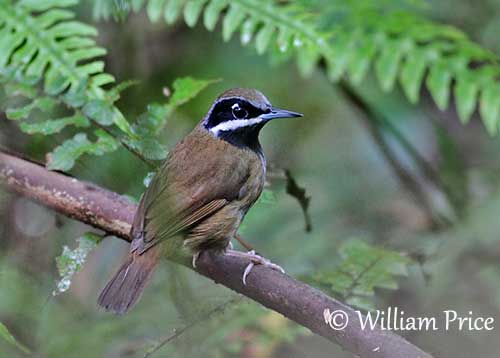
Other examples of avian adaptive radiation on remote islands include the Darwin's Finches on the Galapagos Islands, and the Hawaiian honeycreepers in the Hawaiian Islands. The Darwin's Finches show the diversification of a single population into several taxa adapted to various environmental niches on Galapagos and Cocos Islands. The Hawaiian honeycreepers have adapted to a new environment through changes in bill shape and coloration.
The Malagasy vangas may surpass both previous examples by the number of genera and the diversification of body size, bill shape and plumage coloration.
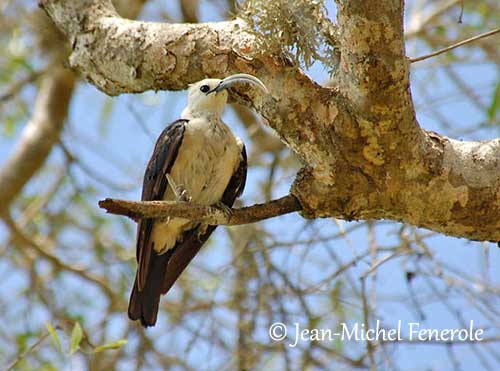
Vanga’s origin is an interesting question. From other analysis by A. Manegold in 2008, the “true” vangas formed a monophyletic group with the Artamidae (Australasian woodswallows) and the Cracticidae (Australo-Papuan butcherbirds). If this relationship were to be confirmed, it would imply that vanga’s ancestor reached Madagascar from the east, through a dispersal across the Indian Ocean.
But this proposal is in conflict with contemporary hypothesis derived from DNA-sequence analysis giving other close relatives such as helmet-shrikes, bush-shrikes and platysteirids, indicating an African origin of the vangas.
However, this hypothesis accords in part with W.P. Pycraft findings published a century ago, in 1907. William Plane Pycraft was an English osteologist and zoologist.
The family Vangidae is still relatively poorly known, but these interesting birds play a leading role in Madagascar’s ecotourism industry, as symbols of the originality and uniqueness of the animal’s life of this region.
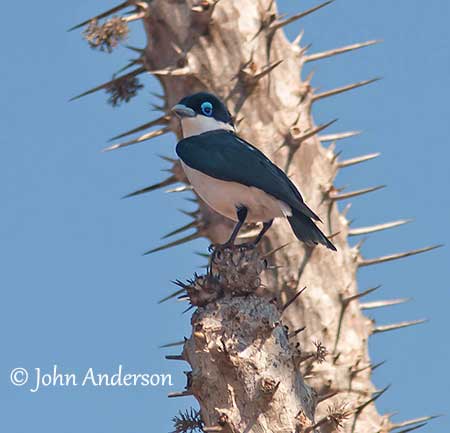
The birds of the family Vangidae are rooted in people’s life on the island. The Malagasy names of the members of this family are derived from their songs, plumage colour or behaviour.
There are some examples such as the Sickle-billed Vanga, named “Voronjaza” that means “bird of the children” because some calls are similar to the crying of an infant. The Hook-billed Vanga is named “Vangasoratra” that means “the black-and-white bird”. The Nuthatch Vanga is named “Voronakodidina” that means “bird turning and climbing around the tree”. On the other hand, the Red-tailed Vanga is mostly described from its song “toto toto karasoka toto toto karasoka” and its Malagasy name is “Totokarasoka”.
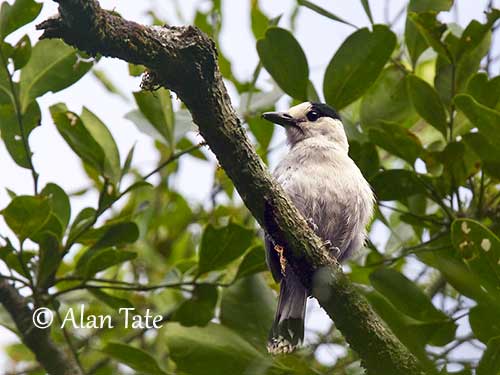
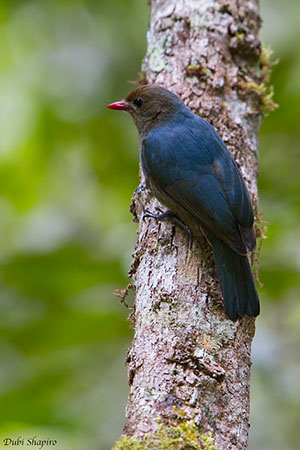
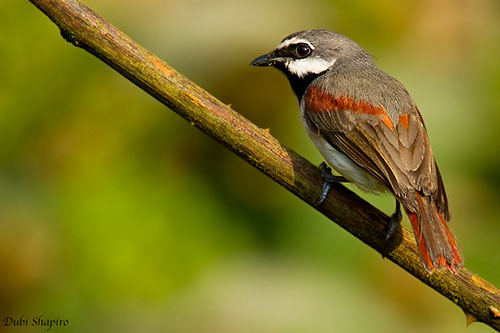
The vangas have a wide repertoire of calls, with complex vocal communication, from the cawing of the Sickle-billed Vanga to the angry rattle of the Madagascar Blue Vanga. The call of the Hook-billed Vanga is a penetrating, high-pitched whistle difficult to locate. Generally, the vangas utter various whistles, and some of them can be melodious like the Rufous Vanga’s call. Within mixed-species groups, the alarm call of this species attracts many other birds to the scene, and they mob the predator together.
The vangas are fairly different from each other in size, bill shape and colour, and these morphological divergences still involve taxonomic confusion. They range from 12 to 32 cm in length, and the plumage colour is varied. Some species show sexual dimorphism.
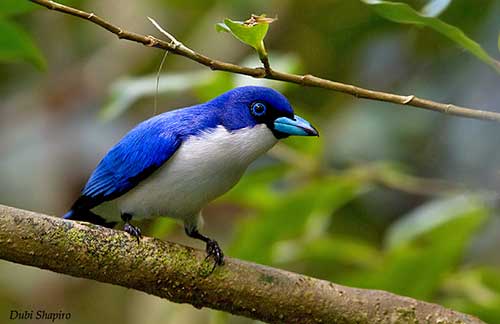
We can find several plumage colours and most vangids have white underparts. The genus Calicalus has greyish, white and rufous plumage, whereas the genus Vanga is black and white. The genus Oriola shows sexual dimorphism with black male and brownish female. The genus Xenopirostris is blackish/greyish and white, but the Pollen’s Vanga shows sexual dimorphism. Falculea and Artamella genera are black and white, with very specialized bill in Sickle-billed Vanga.
The genera Leptopterus and Cyanolanius show blue tones, darker in Leptopterus, and white underparts. The genus Schetba has rufous plumage with white underparts. Male and female differ slightly in amount of black on the head. The genus Euryceros is rufous and black, but it has a massive, distinctive bill. The genus Tylas resembles Pollen’s Vanga and shows some sexual dimorphism. The genus Hypositta is the smallest vangid, with pale bluish-grey plumage overall in male, and rufous-grey head and underparts in female.
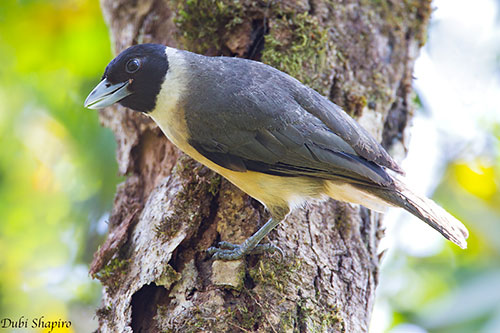
Female
The bill shape varies widely, and by using the analogy of gripping tools, we can find several basic bill types such as forceps type, radio pliers type, strong pincers type, pliers type and generalized type, the latter divided into the standard type and the flat forceps type.
Thanks to their bills, the vangas occupy niches that should be filled by woodpeckers, woodhoopoes, shrikes, tits, treecreepers and nuthatches which are absent from the island of Madagascar. The bills reflect the type of prey taken, the feeding behaviour and the site where the prey is caught.

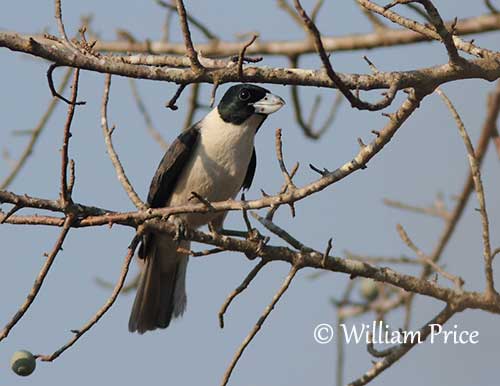
The vangas feed on small or large invertebrates, mostly insects but also spiders and worms, depending on bird and bill sizes. They also take small vertebrates such as lizards, chameleons and geckos. They are arboreal species, spending most of their time foraging in trees within the territory. However, some of them come to the ground, and especially the Rufous Vanga which hops while searching for prey.
The Hook-billed Vanga takes frogs, small birds, bird eggs and sometimes young lemurs. In addition to insects, berries are consumed by Chabert’s Vanga and Madagascar Blue Vanga, whereas the White-headed Vanga feeds on some fruits or seeds. The large, spiky or armoured prey items are dismembered before to be swallowed. They forage at all levels of the vegetation, from the forest floor to the canopy according to the species. They use five main foraging techniques including gleaning, hovering, probing, snatching and hawking. They tend to forage alone or in pairs, or in small family groups.
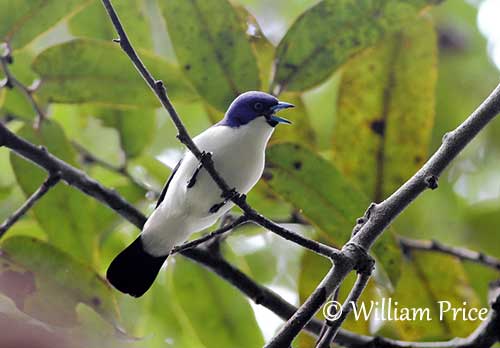
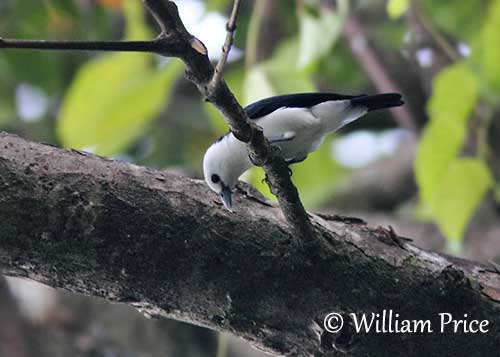
They also join mixed-species foraging flocks outside the breeding season.
Some species such as the Sickle-billed Vanga, the White-headed Vanga and the Chabert’s Vanga show communal roosting behaviour. They use the same tree at roosting site throughout the year.
The Vangidae usually frequent all types of forest habitats in Madagascar. They can be seen throughout the island, except for the central plateau where small shrubs are patchily distributed. There are two distinct regions, the dry western part with deciduous broadleaf forest, and the humid eastern part with tropical or montane rainforest. The southern region has semi-arid climate and the vegetation include thorn-forest with plants adapted to arid environment. The distribution of each vanga species depends on both climate and vegetation.
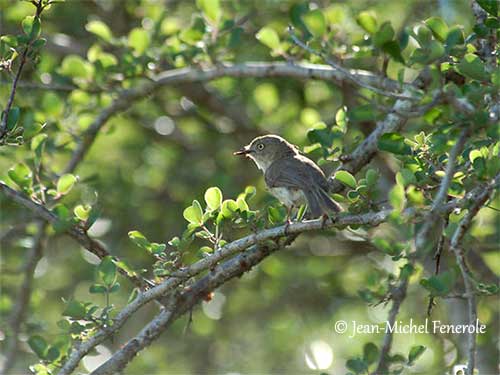
Most species breed in the southern summer, from September to January with only some latitudinal and altitudinal variations. The breeding season starts at the end of the dry season and continues into the middle of the rainy season.
The courtship displays are poorly known except those of the Sickle-billed Vanga, during which the female courts the male with any display in return. We can suggest that the bright-coloured head pattern of some species is enhanced by adapted postures accompanied by calls.
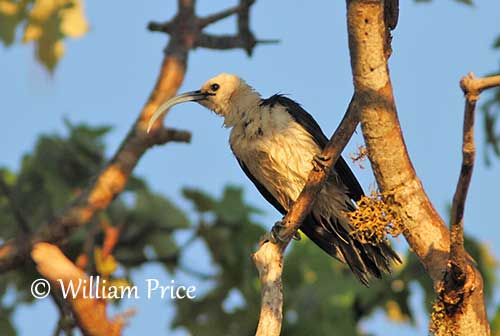
The Vangidae are basically monogamous, but there is considerable diversity within this family. They exhibit variations in co-operative breeding, involving some different breeding systems.
The Rufous Vanga may breed in simple pair or with helpers, usually immature males of the previous year that help in territory defence and mobbing of predators, and less often chick-feeding. The White-headed Vanga has fairly similar breeding system, and this “helping” behaviour may be more widespread among Vangidae.
From several observations, unmarked individuals have been reported while attending the nest or assisting with nesting duties such as nest-building in Chabert’s Vanga and Bernier's Vanga. However, any helping behaviour has been observed at nests of Helmet Vanga, Hook-billed Vanga, Van Dam’s Vanga, Pollen’s Vanga and Tylas Vanga. These species breed in simple pair and both mates share the nesting duties.
Both Sickle-billed Vanga and Bernier's Vanga have a co-operative polyandry breeding system. The group consists of a single female and several males that copulate with her. In this system, the males perform the nesting duties, including chick-rearing.

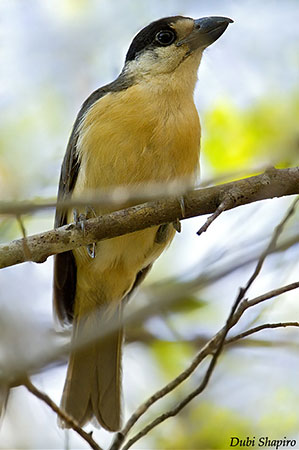
Female
We can find four basic types of nest. A large bowl-shaped nest made with piles of twigs is made by the Sickle-billed Vanga. The Nuthatch Vanga places pile of moss in a hole in tree trunk. Rufous Vanga, Hook-billed Vanga and Helmet Vanga build a small, bowl-shaped structure in tree fork. The remaining species make a small cup-shaped nest with varied size and location. Usually, the material used for the nests reflects the surrounding habitat.
Two to four pale eggs with dark markings are laid according to the species. The incubation period ranges from 16 to 19 days, but the Hook-billed Vanga needs about 22-24 days and the chicks leave the nest 20-22 days after hatching.
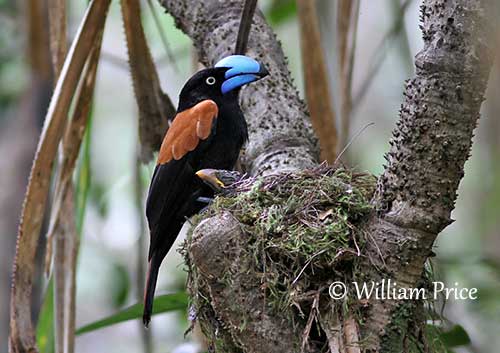
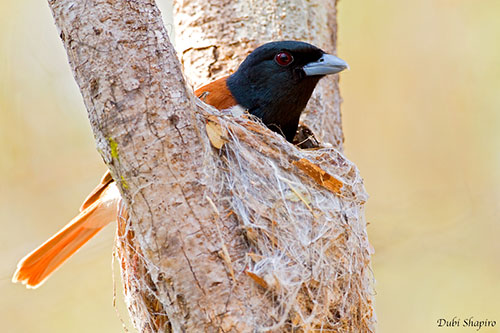
Male
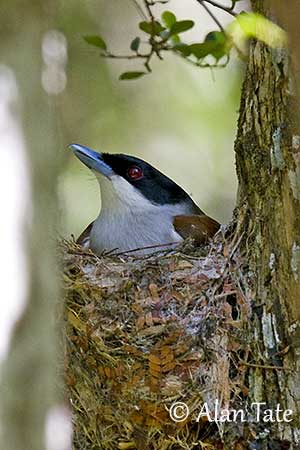
Female
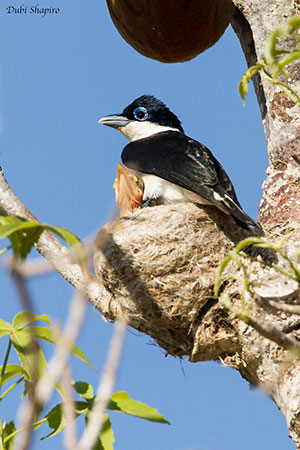
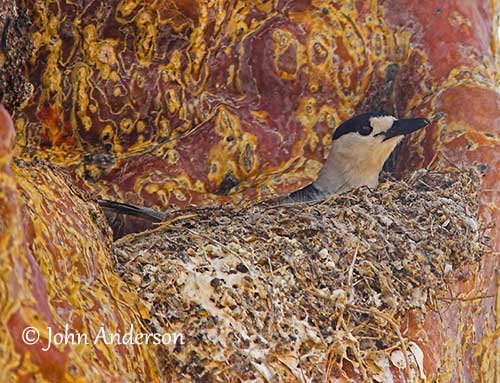
The predators of the nests are not well known. From some observations, at most failed nests, all the eggs or the entire brood of nestlings disappeared at the same time. This type of attack is probably that of snakes, lizards, lemurs and hawks. The vangas mob predators such as couas, drongos, brown lemurs and snakes. The pair or the members of a flock gather near the predator while uttering short, sharp alarm calls. They may approach the predator and some birds display aggressively, arching the neck and drooping the wings.
The vangas are sedentary in Madagascar where they occupy the territory all year round.
They have short wings and only perform short-distance flights.
The vangas can be found in forested habitats throughout Madagascar, and most of them are fairly common in suitable habitats. However, some species are sometimes locally absent or rare. The short-distance movements of this family need to be studied in order to protect these birds, some of them being listed as Endangered.
They are mainly threatened by habitat loss through forest clearance for agriculture expansion. But bushfires, commercial logging and exploitation of timber are additional adverse factors. The Madagascar’s endemic birds, including the vangas, are closely related to conservation of forests.
There are numerous protected areas on the island, including forest reserves and National Parks, where the birds can live, but the rate of forest clearing outside these areas is still high and remains the main threat.
The originality and the uniqueness of Madagascar must be protected and more scientific studies are required, in order to determine the needs of each species and to establish detailed conservation strategies.
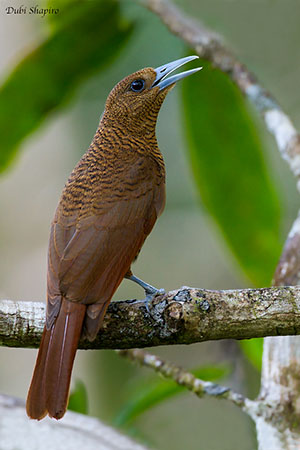
Female
